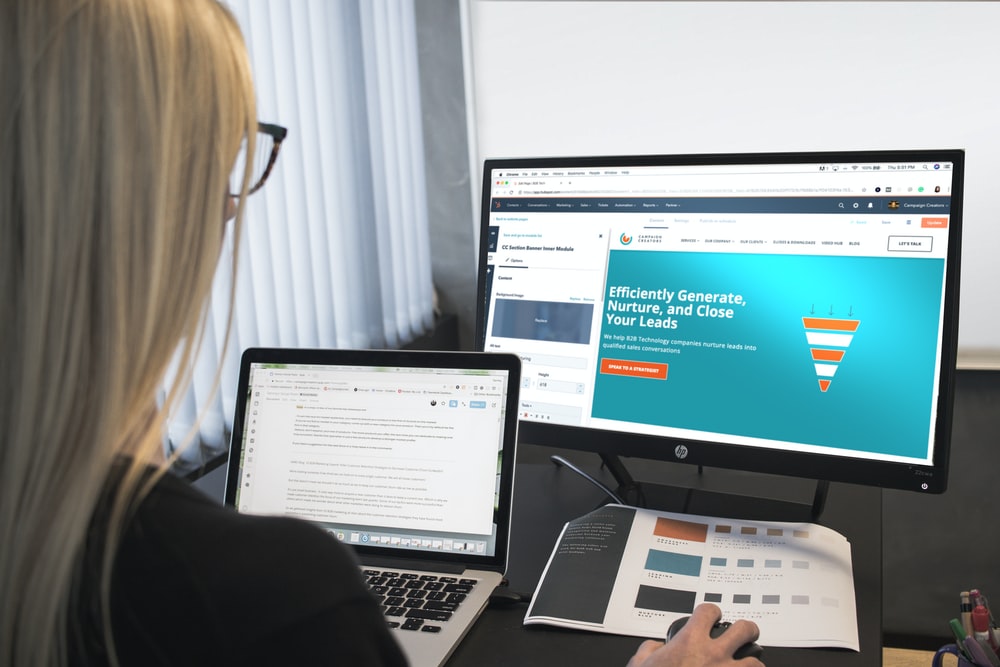What Is Inbound Marketing?

Inbound Marketing: A term used to describe the process of attracting customers through content and interactions that are relevant, valuable and trustworthy. In other words, it’s about creating a positive experience for your audience so they want to do business with you.
The goal of inbound marketing is simple…to attract more leads by providing great experiences and value-driven communications which build trust over time. And this can be done at any budget level.
Why Use an Agency vs Doing It Yourself?
1) Agency has access to tools & technology not available on their own
2) Agencies have experts who know how to get results
3) They will help you understand what works best for your company/brand
4) You don't need to worry about hiring someone or managing employees - we take care of everything!
5) We're here every step of the way helping guide you along the way.
6) The cost savings alone make using an agency worth it!
7) It's easier than ever before to find quality professionals like us. Just search "inbound marketing" + your city.
8) If you hire us as your agency, we'll work closely with you to ensure you receive all the benefits listed above.
9) Our team members are highly skilled and experienced in digital marketing strategies.
10) Your success is our top priority.
11) We offer ongoing support after project completion.
12) We provide training opportunities for new hires.
13) We love working together and would love to hear from you soon!
14) Contact Us today to learn more about how we can help you succeed online.
SaaS Inbound Marketing Strategy
Step 1 - Identify Your Ideal Customer Profile & Customer Segments
Before starting any SaaS campaign, you must identify your ideal customer profile. This means defining exactly who your target market is and where they hang out online. Once you've identified your ICP, then you can start building campaigns specifically targeted towards these people.
Here are some questions to ask yourself when determining your ICP...
Who am I trying to reach? Who is my ideal client? What kind of person does my product appeal to? How much money do they spend per year? Where do they go online? Are there certain types of products they prefer? Do they tend to buy things based off reviews?
Once you've answered those questions, you can begin segmenting your potential clients into different groups based on similar characteristics. For example, if you sell software, you might create three segments:
• Software Developers
• Small Business Owners
• Large Enterprises
Each group may require slightly different messaging and offers but ultimately, each one needs to feel unique enough to stand apart from the others.
You also need to consider whether you'd rather focus on men or women. Some businesses choose to only cater to males while others only target females. Either way, you still need to determine who your ideal customer is and tailor your messages accordingly.
Step 2 – Create Personas
Personas are fictional characters designed to represent specific demographics within your target market. Each persona represents a distinct set of behaviors, attitudes, interests and motivations. They should be able to accurately describe their own buying behavior and preferences.
Persona creation involves creating profiles that include information such as age, gender, income level, occupation, hobbies, personality traits, etc. These details will allow you to better understand your audience so you can craft content that resonates with them.
The goal of this exercise is not just to have fun; it’s to get inside your customers' heads and figure out why they want to use your service. For an example of successful customer engagement, see our Patsnap case study. By doing this, you’ll know which features matter most to them and which ones could potentially turn them away.
To build effective personas, try asking yourself the following questions:
What motivates them to purchase?
How often do they shop online?
Where do they typically look for deals?
Do they read reviews first? Or rely solely on price?
Are they looking for something simple or complex?
Which social media platforms do they frequent?
Is technology important to them?
What type of device do they primarily use?
What other services do they already subscribe to?
What makes them tick?
What problems do they face daily?
What issues keep them up at night?
What keeps them awake during the day?
What do they dislike about current solutions?
What do they enjoy about existing solutions?
What do you think they wish existed?
Step 3 - Customer Journey Development
Now that you have created your personas, it's time to start thinking about how people actually interact with your brand. This process is called customer journey development. It helps you identify where your prospects currently are in the decision-making process and what steps they take before making a final purchasing choice.
A good place to start is by mapping out all the touchpoints between when someone becomes aware of your business and when they make a purchase. You'll then need to decide what happens after they become interested in your company. Is there an email campaign you send them? A phone call? An offer sent via text message?
This step is crucial because it allows you to see exactly how far along your prospect has gone through the sales funnel. If you find that many of your leads aren't ready to commit yet, you'll need to adjust your strategy accordingly.
For instance, if you're selling a car insurance policy, you won't likely receive any interest until the lead reaches the point of being willing to sign a contract. At this stage, he or she would probably visit your website, fill out some forms and request more info. Once you've received his contact information, you can follow up with him/her directly using emails and calls.
If you notice that your leads don't seem very engaged, you may need to rethink your approach. Perhaps you need to provide additional value to convince them to move forward.
Step 4 - Keyword Research to Identify Search Opportunities
Once you understand who your ideal buyers are and their buying behavior, it's now time to focus on keywords. These words will help search engines like Google better understand what kind of content you should be creating so that it matches the needs of those potential clients.
Keywords also play a big role in SEO Services, as well as paid advertising campaigns such as Facebook ads. The right keyword research tools allow you to quickly discover new opportunities based on specific criteria. For example, let's say you sell dog food. Your target audience might include pet owners, but you'd still benefit from knowing whether "dog" or "puppy" yields higher conversion rates.
You can easily create these types of reports manually, but we recommend investing in software that does the heavy lifting for you. Some popular options include SEMrush, Ahrefs, SpyFu, BuzzSumo, Market Samurai, WordStream, and Moz Pro.
These programs give you access to tons of data including traffic sources, competitors, top searches, and much more. For more insights, check out our article on Data-Driven Marketing. They even show you how long users spend on each page and what pages bring visitors back again and again. All of this valuable insight comes together into one easy-to-read report.
Step 5 - Create Content Mapped to the Customer Journey
Once you understand who your ideal buyer is, you should be able to create content that speaks specifically to their needs. The best way to do this is to map out each individual step of the buying cycle so that you can write copy that resonates with your audience throughout every phase of the sale.
You might even consider creating multiple versions of your landing page depending on whether the user is new to your site or returning from another source. For example, if someone visits your homepage but doesn't click anything, you'd better give them a reason to stay!
In addition to writing compelling headlines and descriptions, you also need to include CTAs that encourage users to complete specific tasks like filling out forms or downloading apps. These buttons will help convert visitors into buyers.
Finally, remember that your product pages must contain everything necessary to persuade potential clients to buy. Include pricing tables, detailed specs, testimonials and videos demonstrating how your solution works.
Step 6 - Test Your Copy & Landing Pages
After you've written great content, tested your CTA button placement and optimized your images, it's finally time to test your entire conversion path. To ensure success, you'll need to run split tests across different variations of your landing pages.
These experiments allow you to measure the impact of changes such as adding a video demo, changing the headline or removing certain elements altogether.
What Is a Sales Funnel?
In order to understand the importance of creating a strong sales funnel, let's define what one really is. The term "funnel" refers to a series of stages that help guide potential buyers from awareness to conversion into paying clients. In essence, a funnel consists of three main parts: Awareness, Interest & Decision. Each part represents a different phase in the buying cycle.
Sales Funnels Explained | Definition & Examples
When we talk about building a successful sales funnel, we mean designing each element so that it encourages visitors to progress through the various phases of the buyer's journey. For example, if you sell cars, you might create a landing page that offers free test drives. Then, once users click through to view those pages, you'd design another set of pages that focus on educating them about their options. Finally, you'd include a third group of pages that encourage them to buy.
If done correctly, these elements will ensure that your site converts as much traffic as possible into paying customers. However, if you skip certain sections of the funnel, you risk losing valuable leads who never reach the end result.
Here's What Happens When Your Leads Don't Convert
As mentioned earlier, every single interaction with a visitor should be designed to convert them into a qualified lead. But sometimes, even though you've followed best practices, things still go wrong. Here are four common reasons why your leads fail to convert.

What Is Tofu? (Top of The Funnel)
The first thing people do when visiting your site is look for something specific. This could be anything from finding a product description to learning about your services. So, before you start sending them anywhere else, make sure they know precisely what they want by providing clear content.
You also have to keep in mind that not everyone wants to hear everything at once. Some prospects prefer to learn about products gradually while others just want to get straight to the meaty stuff. To accommodate both types of individuals, you should use CTAs strategically throughout your site. These buttons allow visitors to navigate around your site without having to leave. They also give you the opportunity to direct them towards other areas of your business.
What Is Mofu? (Middle of The Funnel)
While most businesses tend to think of the middle section of the funnel as being all about education and information gathering, this isn’t always true. You can actually find yourself here because you haven’t provided enough value or convinced someone to take action yet. If you're struggling to figure out how to improve your middle-stage conversions, try asking yourself some questions like: Do I offer too many choices? Am I giving my audience too little time to read/think about my message? Or am I simply missing an important piece of content?
How Can We Help Them?
Once you've built up trust with your audience, you'll likely begin receiving more inquiries than ever before. And since you already established rapport with them, there won't be any reason for them to hesitate to contact you again. As such, you'll probably receive lots of emails and phone calls. While this is great news, it does come with its own challenges. Namely, you now have to manage multiple conversations simultaneously.
To avoid getting overwhelmed, you must prioritize which messages deserve immediate attention over others. That way, you can quickly respond to urgent issues while ignoring less pressing ones. It's also helpful to schedule regular meetings with your team members so that you can discuss new ideas together. By doing so, you'll be able to stay ahead of the curve and continue improving your customer service skills.
What Is Bofu? (Bottom of The Funnel)
If you don't provide quality content on your website, then no one will visit it. In fact, if you only focus on creating high-quality content, you may end up spending hours every day writing articles instead of focusing on growing your company. Instead, you need to create content that helps drive traffic to your site. For example, you might write blog posts that answer frequently asked questions, share useful tips, or highlight industry trends.
In addition to generating interest among potential customers, good content has another benefit: it makes your brand seem trustworthy. When prospective clients see that you care enough to put effort into producing engaging material, they'll feel comfortable working with you. Plus, they'll appreciate knowing that their interests matter to you. After all, wouldn't you rather work with a company whose employees genuinely enjoy helping others?
So, whether you're looking to increase sales or build relationships, remember that effective content creation requires planning and patience. Don't expect overnight success; instead, commit to building a solid foundation today. Then, slowly but surely, you'll reap the benefits tomorrow.

.avif)



